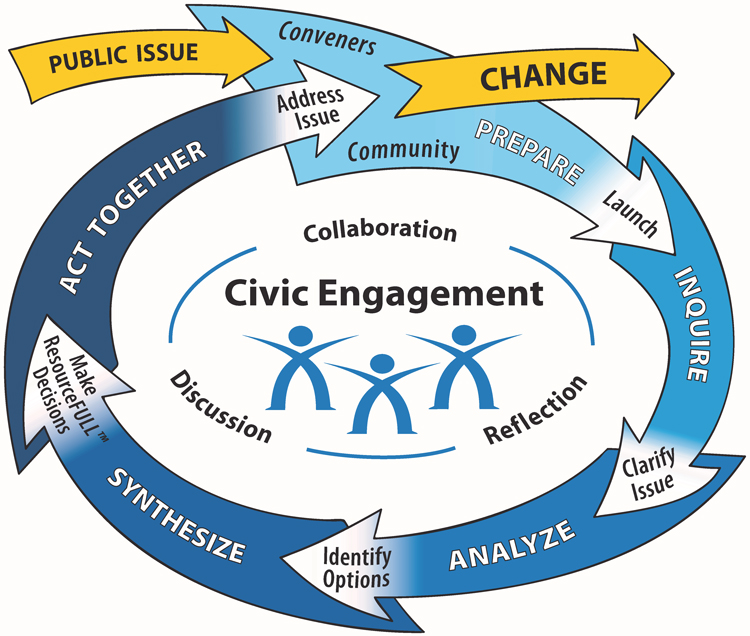NOTE TO READERS: Words in bold indicate key research-informed concepts identified in, and supported by, the University of Minnesota Extension Model for Civic Engagement.
This model represents civic engagement as “Making resourceFULL decisions and taking collective action on public issues through processes of public discussion, reflection and collaboration.” Outcomes of authentic civic engagement are resourceFULL decisions and collective action. This requires intentionality and a holistic, rather than piecemeal, approach to process design and management.
Authentic civic engagement builds trust and relationships with the public. Trust is needed for relationships to develop. Relationships are needed to get work done. It is important for conveners to shift from a meeting mindset to a civic engagement opportunity.
A resourceFULL decision is one based on diverse sources of information and supported with buy-in, resources (including human), and competence. Obtaining diverse sources of information requires intentionality about who is engaged to provide a wide range of perspectives, knowledge, wisdom and experiences relative to the public issue.
At the heart of effective civic engagement is processes that support genuine discussion, reflection and collaboration.
- Discussion includes both dialogue and deliberation.
- Dialogue is discussion to promote understanding.
- Dialogue informs deliberation.
- Deliberation is discussion aimed at reaching a decision.
Two partners in civic engagement are the conveners and the community. Conveners are responsible for creating a collaborative environment. Three key elements to effective collaboration are credible data, appropriate people and constructive process.
Similarly, these are three key elements associated with community:
- the role community will be asked to fulfill,
- how communication and engagement will occur, and
- who will be engaged.
The holistic approach to civic engagement consists of five stages. These are:
- Prepare: Understand the context in which the issue will be addressed to assess community readiness. This phase ends with a decision to launch work on the public issue using civic engagement (public discussion, reflection and collaboration).
- Inquire: Conduct dialogue to better understand all aspects of the issue. The presenting issue is explored and clarified to determine possible underlying issues. Deliberation occurs to frame the issue.
- Analyze: Foster dialogue to explore various perspectives and viewpoints and deepen understanding of the issue. Deliberate to generate options.
- Synthesize: Conduct dialogue to align the clarified issue with identified options. Deliberate to reach a resourceFULL decision and translate the decision into a plan.
- Act Together: Use created trust and relationships to take collective action to address the issue. (Implement.)
A WORD ABOUT PROCESS: Process design and process management are fundamental to effective civic engagement. Intentional alignment and design of dialogue and deliberation – for each of the five civic engagement stages – is critical.
Process includes careful question design. If you ask the wrong questions, you get the wrong answers. Skills in listening, questioning, and framing are important to civic engagement processes.
- Fagotto, E., & Fung, A. (2009). Sustaining public engagement: Embedded deliberation in local communities. East Hartford, CT: Everyday Democracy, & Dayton, OH: Kettering Foundation.
- Chrislip, D., & Larson, C. (1994). Collaborative leadership: How citizens and civic leaders can make a difference. San Francisco, CA: Jossey-Bass.
- Bryson, J. & Crosby, B. (1992). Leadership for the Common Good: Tackling Public Problems in a Shared Power World. San Francisco, CA: Jossey-Bass.
Consult with us
Community economics • Leadership and civic engagement • Tourism
Extension educators work in communities with partners throughout Minnesota. Contact us for consultation, guidance and conversation about your community.


